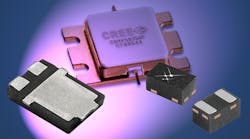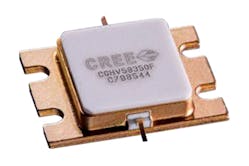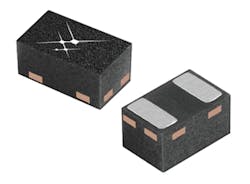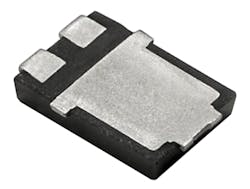This file type includes high-resolution graphics and schematics when applicable.
Many different active circuits are based on two essential semiconductor function blocks—diodes and transistors. In analog, digital, and mixed-signal circuits, diodes and transistors both provide different types of switching functions, while transistors also supply signal amplification when needed.
Diodes and transistors of various types are used at RF and microwave frequencies, depending on required function and frequency range. Knowing how the different semiconductors behave can simplify the task of specifying disparate diodes and transistors for a wide range of RF/microwave applications.
Put simply, a diode is a two-terminal semiconductor device and a transistor is a three-terminal semiconductor device. A diode can allow the flow of current in one direction while blocking the flow of current in the other direction. The device works well as a switch, and is useful for limiting signal levels, frequency multiplication, tuning, and protecting circuitry from the flow of current in a given direction. Often, diodes also function as rectifiers to convert alternating current (ac) to direct current (dc) in a circuit.
Transistors are versatile semiconductor devices fabricated from many different chemical elements and compounds, such as silicon (Si), gallium arsenide (GaAs), and gallium nitride (GaN). They can be used as amplifiers or switches, with frequency dependent on device structure, dimensions, and material properties. With the three terminals, a voltage or current applied between one pair of terminals can affect the voltage or current between another pair of terminals to produce gain as needed for an amplifier or an oscillator. Depending on the application, a transistor may be operated a low power levels in its small-signal or linear region, or at higher power levels in its large-signal or nonlinear region.
An Array of Options
Diodes and transistors have been developed and fabricated in many different forms. Diode types include Schottky-barrier, positive-intrinsic-negative (PIN), Gunn, Impatt, and varactor-tuning diodes. Transistor types essentially include field-effect transistors (FETs), such as metal-oxide-semiconductor FETs (MOSFETs) and metal-epitaxial-semiconductor FETs (MESFETs), and bipolar junction transistors (BJTs), such as heterojunction bipolar transistors (HBTs).
The two terminals of a diode are known as the anode and the cathode. The three FET terminals are called the gate, drain, and source, while the three bipolar transistor terminals are referred to as the emitter, collector, and base. In either type of transistor, charge is transferred in a controlled manner between two terminals: between the source and the drain in an FET and between the emitter and the collector in a bipolar transistor. Current flows laterally in an FET and vertically in a bipolar transistor.
A bipolar transistor essentially consists of two junction diodes on semiconductor material having positive (p) and negative (n) polarities. A transistor with two positive layers surrounding a negative layer is known as a pnp transistor, and a device with two negative layers around a positive layer is an npn transistor.
Choosing a transistor for a high-frequency application generally hinges on frequency range as well as performance. For example, in receiver applications, signal sensitivity is critical and the noise figure of a receiver front-end transistor as used in a low-noise amplifier must be as low as possible. Thus, GaAs FETs might be the best option, since they are available with impressively low (under 1 dB) noise figure at microwave frequencies.
Such transistors are characterized for use in their linear, small-signal regions, with the tradeoff being that output power is limited to generally less than 1 W. For higher power amplification, GaN is usually the semiconductor material of choice at present for microwave frequencies, typically in the form of a flange-packaged power GaN HEMT device (Fig. 1).
Pinpointing the Right Diode
Selecting a diode for a particular RF/microwave application is more a matter of understanding which type of diode performs what type of function. For example, Gunn diodes, which are also known as transferred electron devices (TEDs), are typically employed to generate RF/microwave signals and/or detect signals, such as in radar detection. Named after John Battiscombe (JB) Gunn, this type of diode exhibits a voltage-controlled negative resistance. It is usually fabricated from a single piece of n-type semiconductor material, such as GaAs or indium phosphide (InP), and can produce oscillations well through the millimeter-wave frequency range.
Schottky diodes, named after Walter H. Schottky, are often used for frequency translation in mixers or for signal detection (Fig. 2). They feature low forward or turn-on voltage and fast recovery time. These rectifying diodes are often found in circuits with multiple power supplies, such as an ac source and a battery, to prevent one source of power from feeding into the other.
The high-power Impatt diode, short for “IMPact ionization Avalanche Transit-Time diode,” is typically used to generate signals. The negative resistance possible in the device allows it to act as an oscillator, although for applications where phase noise is not critical compared to a frequency synthesizer. Impatt diodes also often act as local-oscillator (LO) sources in integrated receivers. As with many diodes, it can conduct current in the forward direction and blocking current in the reverse direction.
Perhaps the workhorse of all RF/microwave diodes is the PIN diode, commonly used in high-frequency switches and attenuators (Fig. 3). The name derives from its three layers of p-type, intrinsic, and n-type semiconductor materials. The p-type layer holds the anode while the n-type layer forms the diode’s cathode. PIN diodes, which are fabricated from both silicon and GaAs semiconductor materials, act like current-controlled resistors. The more current that flows through the intrinsic region in turn decreases the device RF resistance. A PIN diode behaves like an open circuit, like a short circuit, and anywhere in between. It can be current-tuned to a required impedance, such as 50 â¦, for impedance-matching purposes.
A PIN diode acts like a rectifier at lower frequencies and as a variable resistor at RF/microwave frequencies. The frequency at which the diode changes from rectifier to variable resistor is a function of the intrinsic layer’s thickness. Thicker devices can be used as switches to lower frequencies. Very low current levels are needed to control PIN diodes that can handle high amounts of RF/microwave signal power.
Varactor diodes are also widely used in high-frequency applications, for frequency multiplication as well as tuning purposes. Exhibiting a capacitance that varies as a function of applied reverse voltage, varactor diodes are commonly used to tune the frequency of oscillators like voltage-controlled oscillators (VCOs).
Reaching into the Past and Future
Finding older RF/microwave diodes and discrete transistors in the marketplace can at times be challenging, especially when they are needed for critical applications such as pulsed amplifiers in commercial or military radar systems. Unfortunately, over the past few decades, many RF/microwave transistor and diode suppliers have changed hands or ceased operating, exacerbating the challenge of finding older semiconductor part numbers for existing electronic circuit designs.
Fortunately, a number of distributors and semiconductor suppliers stock discontinued models and replacement parts for hard-to-find devices. ASI Semiconductor, for instance, manufactures many replacement high-power devices for radar applications that are unavailable from companies no longer in the market, such as Motorola. It also offers microwave diodes no longer supplied by companies such as Alpha Industries and Avago Technologies. High-power transistor types include older silicon MOSFET and silicon bipolar transistors.
In terms of recent advances, a great deal of interest has surrounded graphene as a semiconductor material for next-generation transistors. Described as a “zero-bandgap” material for its high electron mobility, graphene can achieve high current density. The material is formed of a one-atom-thick layer of carbon atoms arranged in a honeycomb lattice. It is suitable for high-frequency, high-speed transistors through millimeter-wave frequencies, and as the basis for photodetector diodes for use in optoelectronic circuits and systems.
Graphene FETs have been fabricated with cutoff frequencies beyond 30 GHz. They are of particular interest for flexible circuits, though, in wearable electronic devices. Such devices, which include different types of temperature and motion detectors, are being designed with wireless transceiver capabilities for use as Internet of Things (IoT) wireless devices. In addition, researchers continue to search for ways to scale semiconductor dimensions smaller in size. The goal is to develop practical transistors and diodes for short-range millimeter-wave or even terahertz (THz) frequency wireless communications in support of the expected higher wireless data rates needed for IoT applications.




